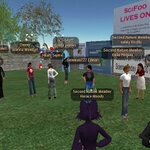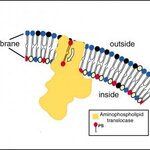Science Education & Policy

Research can often be a thankless job for the researcher - logically even more so if you make your data available to the community at large. Someone in the peer community will challenge it, bloggers will pick it apart, newspapers will misinterpret it and someone, somewhere, will find a way to use it to bolster their favorite political argument.
The benefits of open science to the science community receiving the data are obvious. They get results without effort or money or time. Is there any benefit to the researcher and, if not, why would anyone do it?
The authors of the study Sharing…

We had our first SciFoo Lives On session today on Nature Island (Second Nature) in Second Life. We had about a dozen people participate.
The topic was "Tools for Open Science". I wanted to explore more fully the actual technology that people are starting to use towards doing more open science. I started off by showing screenshots of UsefulChem wiki and blogs from my poster. The other posters there (and still there) included MyExperiment, Nature Precedings, Bill Hooker's Thoughts, Knowble and Connotea.
Overall it went very well I think. Initially I was disappointed that most people did…

Huntington disease (HD) is a neurological disorder resulting from degeneration of brain cells. The degeneration causes uncontrolled limb movements and loss of intellectual faculties, eventually leading to death. There is no treatment. HD is a familial disease, passed from parent to child through a mutation in the normal gene. The disorder is estimated to affect about one in every 10,000 persons.
Ray Truant, professor in the Department of Biochemistry and Biomedical Sciences at McMaster University and PhD candidate Randy Singh Atwal, have discovered a small protein sequence in huntingtin that…

In 17th century Rome, the Baroque painter Orazio Gentileschi gave all his children the finest art education available. But only one of them—his daughter Artemisia—developed into an artist. In fact, Artemisia matched and surpassed her father's skills, and became the first female member of the Academy of Design in Florence and the only woman to follow and innovate upon the tradition of painting established by Caravaggio.
What creates a great artist like Gentileschi, Van Gogh or Manet? Talent or training?
Artists are both born and taught, says Nancy Locke, associate professor of art history at…

Most modern attempts to decipher how portions of genetic code are translated into physical characteristics are akin to a first-grader trying to sound out a word letter by letter — or, in this case, base pair by base pair.
But University of Florida researchers have developed a computational method that’s more like reading whole words at a time.
In a world where science’s ability to transcribe an organism’s genetic code is growing faster every day, the technique could offer much needed efficiency in translating the seemingly endless string of characters into information that can cure disease…

A team of researchers investigating cholesterol and lipid transport has performed experiments that cast serious doubt on the dominant hypothesis of how the body rids its cells of "bad" cholesterol (LDL) and increases "good" cholesterol (HDL).
A protein called ABCA1 is critical for producing "good" cholesterol: patients who lack the gene for this protein produce no HDL, and as a result, suffer from heart attacks at an early age. An important question is what ABCA1 does that is so important for producing HDL.
The most popular hypothesis was put forth in 2000 by Giovanna Chimini, Group Leader…

Movies such as Spiderman 2 and Speed generate excitement among audiences with their cool special effects. But they also defy the laws of physics, contributing to students’ ignorance about science.
Two University of Central Florida professors show just how poorly Hollywood writers and directors understand science in an article published in the German journal “Praxis der Naturwissenschaften Physik.” Common sense may indicate that people should know the stunts in movies are just make believe, but the professors say that’s not necessarily true.
Some people really do believe a bus traveling 70 mph…

A paper published in the Royal Society journal Interface on 15th August 2007 highlights recent research that predicts that the range and severity of the plant disease phoma stem canker is increased by global warming.
A research team led by Rothamsted Research has used a weather-based model developed to predict the start and severity of epidemics of phoma stem canker, a disease of oilseed rape and other brassicas that causes losses of $900M worldwide, to investigate the consequences of predicted climate change scenarios.
The team of biologists and mathematicians found that warmer winters…

About 40 percent of deaths worldwide are caused by water, air and soil pollution, concludes David Pimentel, Cornell professor of ecology and agricultural sciences.
Such environmental degradation, coupled with the growth in world population, are major causes behind the rapid increase in human diseases, which the World Health Organization has recently reported. Both factors contribute to the malnourishment and disease susceptibility of 3.7 billion people, he says.
Pimentel and a team of Cornell graduate students examined data from more than 120 published papers on the effects of population…

Substance abuse increases among acculturated Hispanic immigrants, according to new research presented today by Oregon State University assistant professor Scott Akins at the American Sociological Association’s Annual Meeting in New York.
The study surveyed 6,713 adults in Washington – of which 1,690 persons identified themselves as “Hispanic.” It is the first of its kind in the Pacific Northwest.
Previous research on the effect of acculturation on drug use has been conducted in states with larger Hispanic enclaves such as California, Florida and the Southwest. In these states Hispanics are…